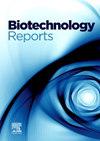在粘菌Amycolatopsis tolypomycina的高G+C基因组数据集中具有保守氨基酸的胞外三酰基甘油水解酶的前瞻性鉴定。
Q1 Immunology and Microbiology
引用次数: 0
摘要
细胞外三酰基甘油水解酶(ETH)对微生物起着至关重要的作用,是在具有挑战性的环境中进行脂质分解和生存的必要工具。通过进化追求更有效的ETH基因和酶具有改善生活条件的巨大潜力。本研究采用蛋白质基因组学方法鉴定了一种显著的革兰氏阳性细菌——粘菌Amycolatopsis tolypomycina的高G+C ETH。利用基因组和机器学习算法的知识,确定了潜在的ETH基因/酶。值得注意的是,ETH对溶剂的结构保守性清晰地显示出特定的16个残基(GLY50、PRO93、GLY141、ASP148、GLY151、ASP172、ALA176、GLY195、TYR196、SER197、GLN198、GLY199、GLY200、GLY225、PRO327、ASP336)无频率。通过精确定位关键残基并了解其作用,本研究为通过计算蛋白质基因组学提高ETH性能奠定了基础,并为酶工程的更广泛领域做出了贡献,促进了针对特定工业或环境背景的更高效、更通用的ETH酶的开发。本文章由计算机程序翻译,如有差异,请以英文原文为准。
Prospective identification of extracellular triacylglycerol hydrolase with conserved amino acids in Amycolatopsis tolypomycina’s high G+C genomic dataset
Extracellular triacylglycerol hydrolases (ETH) play a critical role for microorganisms, acting as essential tools for lipid breakdown and survival in challenging environments. The pursuit of more effective ETH genes and enzymes through evolution holds significant potential for enhancing living conditions. This study employs a proteogenomic approach to identify high G+C ETH in a notable Gram-positive bacterium, Amycolatopsis tolypomycina. Utilizing knowledge from genome and machine learning algorithms, prospective ETH genes/enzymes were identified. Notably, the ETH structural conserved accessibility to solvent clearly indicated the specific sixteen residues (GLY50, PRO93, GLY141, ASP148, GLY151, ASP172, ALA176, GLY195, TYR196, SER197, GLN198, GLY199, GLY200, GLY225, PRO327, ASP336) with no frequency. By pinpointing key residues and understanding their role, this study sets the stage for enhancing ETH performance through computational proteogenomic and contributes to the broader field of enzyme engineering, facilitating the development of more efficient and versatile ETH enzymes tailored to specific industrial or environmental contexts.
求助全文
通过发布文献求助,成功后即可免费获取论文全文。
去求助
来源期刊

Biotechnology Reports
Immunology and Microbiology-Applied Microbiology and Biotechnology
CiteScore
15.80
自引率
0.00%
发文量
79
审稿时长
55 days
期刊介绍:
Biotechnology Reports covers all aspects of Biotechnology particularly those reports that are useful and informative and that will be of value to other researchers in related fields. Biotechnology Reports loves ground breaking science, but will also accept good science that can be of use to the biotechnology community. The journal maintains a high quality peer review where submissions are considered on the basis of scientific validity and technical quality. Acceptable paper types are research articles (short or full communications), methods, mini-reviews, and commentaries in the following areas: Healthcare and pharmaceutical biotechnology Agricultural and food biotechnology Environmental biotechnology Molecular biology, cell and tissue engineering and synthetic biology Industrial biotechnology, biofuels and bioenergy Nanobiotechnology Bioinformatics & systems biology New processes and products in biotechnology, bioprocess engineering.
 求助内容:
求助内容: 应助结果提醒方式:
应助结果提醒方式:


